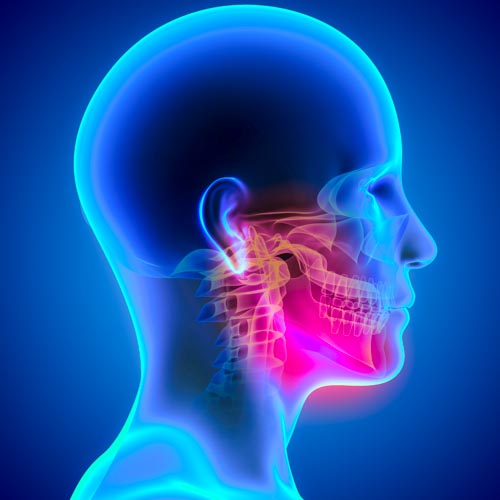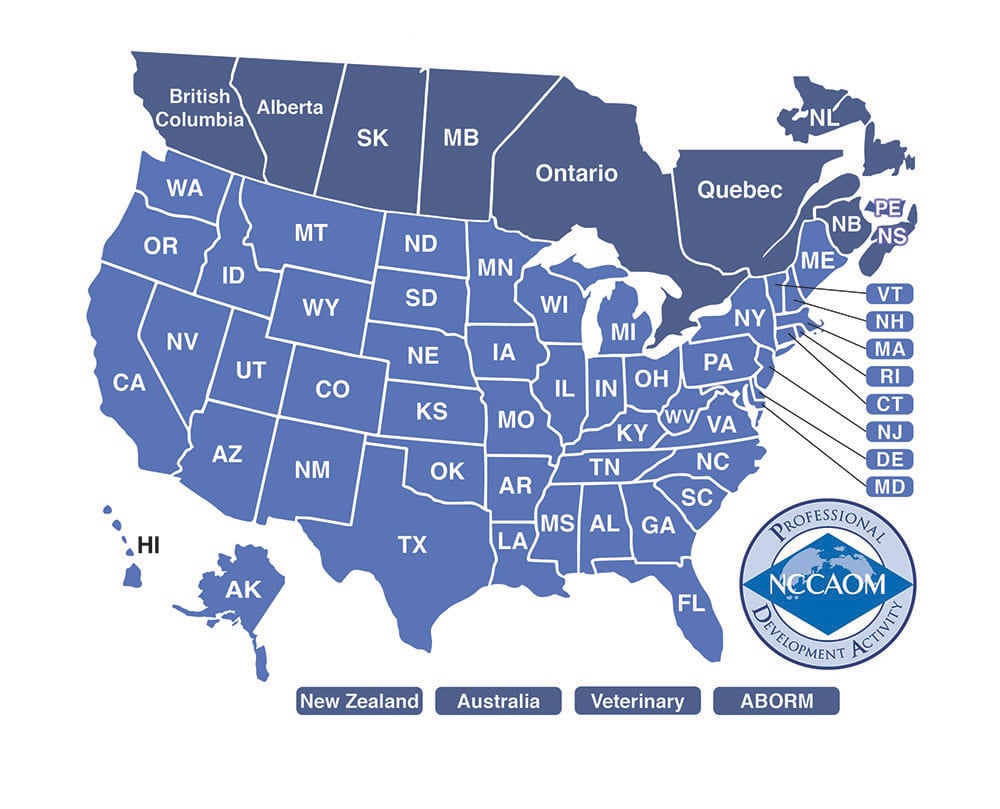TMD / TMJ Orofacial Pain
Samples of Course Material

Sample 1
Introduction
Temporomandibular joint (TMJ) pain and related symptoms are conditions you will likely see in the acupuncture clinic. The temporomandibular joints are the two joints connecting the lower jaw to the skull. TMJ is a blanket term we commonly hear to refer to a collection of joint-related symptoms that affect the face creating mild to severe discomfort. Technically, the TMJ is the anatomical structure, and temporomandibular joint disorder is the pathology. The terms temporomandibular joint disorder (TMD) and temporomandibular joint syndrome are also often used interchangeably. Additionally, you may see the condition referred to as temporomandibular joint dysfunction.
The temporomandibular joint is a complicated structure and it appears the naming of its disorder has been equally complicated. At one time, Costen’s syndrome was considered to be the cause of TMD. In some older literature, you may find TMD also called Costen’s syndrome, a condition named after Dr. James Costen, the otolaryngologist who earlier described many of the symptoms in relation to dental malocclusion. Later, it was referred to as temporomandibular pain and dysfunction syndrome (TMPD) and then just ‘TMJ’ or TMD. For many years, the condition was considered a ...
More in Course Materials...
Sample 2
TMJ Anatomy and Physiology
The TMJ is the most used joint in the body, closing and opening on average 1500 – 2000 times a day. It allows the mouth to open and close, as well as allowing the lower jaw to protrude, retract, and move side to side. The TMJ has an important job assisting us in talking and eating.
This joint is formed where the mandibular condyles and mandibular fossa meet with the articular tubercles of the temporal bone. The two temporal bones are major bones of the head, forming the inferior lateral aspects of the cranium and part of the floor of the cranium. The mandible is the largest and strongest bone of the head. Besides the auditory ossicles, the mandible is the only other bone in the head that moves. The bony surfaces of this joint may be seriously affected by trauma, bruxism (grinding of the teeth), arthritis, poor alignment of the teeth, and congenital defects. The TMJ is classified anatomically as a synovial joint (fluid-filled cavity) comprising…
More in Course Materials...
Sample 3
Pattern Differentiation
Several patterns may lead to TMD. In this course, we explain only seven possible patterns. The following are those seven possible patterns, but please note, other patterns may also apply:
• Liver qi stagnation due to stress and emotional issues
• Local Qi and blood stagnation due to trauma
• Wind-cold bi (painful obstruction) syndrome
• Heat bi (painful obstruction) syndrome
• Damp-heat bi (painful obstruction) syndrome
• Cold bi (painful obstruction) syndrome
• Liver and Kidney Deficiency with damp retention (Rheumatoid Type TMD)
The following are some primary symptoms you may see with each of the seven patterns:
1. Liver Qi stagnation - Anxiety, depression, anger, frustration, facial muscle tension, neck pain, earache, may have tenderness along the Gallbladder meridian, tinnitus, headaches (especially temporal headaches if the Gallbladder involved)
T – Normal body; thin, white coating
P – Wiry
2. Local Qi and blood stagnation due to trauma – History of direct blow to the jaw or other trauma, bruising, swelling, facial pain, earache, tinnitus, deviation of the jaw, limited jaw movement
T – Purplish body; thin, white coating (veins underneath may be distended)
P – Choppy or wiry
3. Wind-cold bi – Pain that changes position, acute onset, may have aversion to wind or cold, slight fever or slight chills, earache, tinnitus, pain in occipital region
T – Normal body; white coating
P – Soft or superficial, possibly slow
4. Hot bi – Skin feels hot around the joint, redness, fever, facial pain, earache, may desire cold liquids
T – Red body or tip; thin, yellow or thick, greasy yellow coating
P – Slippery or fast
5. Damp-heat bi – Acute or chronic onset, heat is trapped in dampness, skin feels hot around joint, numbness, tingling, swelling, dull achy pain, foggy brain (usually damp sinks but heat may be trapped in dampness)
T – Normal or pale body; thin, yellow or thick, yellow greasy coating
P – Slippery
6. Cold bi – Skin feels cold around the joint, acute onset, muscle tightness, stabbing pain, facial pain, headaches, spasms, aversion to cold, pain alleviated by warmth, pain worse in cold weather
T – Normal or pale body; thin, white coating or wet
P – Tight, superficial or deep, slow
7. Liver and Kidney Yin Deficiency (Rheumatoid Type TMD)...
More in Course Materials...
Sample 4
Acupuncture Treatment
Some basic local body points for TMJ are GB 2, ST 6, and ST 7. Distal body points include SI 1, SI 3, and LI 4. The acupuncturist can also use auricular points such as TMJ, upper jaw, lower jaw, cervical spine, trigeminal nerve, and occiput.
The following are suggested protocols based on the seven patterns listed above:
1. Liver Qi stagnation - Soothe Liver and Gallbladder, clear heat if needed, promote circulation, alleviate pain
- LV 3 – Expels interior wind, promotes circulation, subdues Liver yang, calms the mind
- LI 4 – Command point for mouth and face, treats facial problems, treats toothache and headaches, unblocks channels, harmonizes descending of Yin and ascending of Yang, promotes circulation, releases the exterior
- SJ 5 – Master point of the Yang Wei channel, releases the exterior, expels wind-heat, unblocks the channels, benefits the ear (coupled with GB 41)
- GB 41 – Master point of Dai channel, treats headaches, resolves damp-heat, promotes smooth flow of Liver Qi (coupled with SJ 5)
- GB 34 – Influential point for sinews (ligaments), relaxes the sinews, major point for all musculoskeletal issues, promotes smooth flow of Qi, resolves damp-heat, unblocks the channels
- GB 2 – Unblock the channels, expels exterior wind-heat, use for ear pain, tinnitus and jaw impairment, major TMJ point
- SI 3 – Benefits the sinews and tendons, expels exterior wind, treats stiff neck, strongest distal point on the SI meridian, unblocks the DU, clears the mind
- ST 6 – Treats spasms of the masseter muscle, major TMJ point
- ST 7 – Clears obstructions, major TMJ point
- Taiyang – Major temporal headache point, opens channels, relieves pain, reduces swelling, expels wind, treats headache and deviation of mouth
2. Local Qi and blood stagnation due to trauma – Move Qi, move blood, alleviate pain
- LV 3 – Expels interior wind, promotes circulation, subdues LV yang, calms the mind
- LI 4 – Command point for mouth and face, treats facial problems, especially treats toothache and headaches, unblocks the channels, harmonizes descending of Yin and ascending of Yang, promotes circulation, releases the exterior
- UB 17 – Invigorates and moves blood anywhere in the body
- SP 10 – Cools blood, dispels blood stasis
- GB 34 – Influential point for sinews (ligaments), relaxes the sinews, major point for all musculoskeletal issues, promotes smooth flow of Qi, resolves damp-heat, unblocks the channels
- GB 2 – Unblocks the channels, expels exterior wind-heat, use for ear pain, tinnitus and jaw impairment, major TMJ point
- SI 3 – Benefits the sinews and tendons, expels exterior wind, treats stiff neck, strongest distal point on the SI meridian, unblocks the DU, clears the mind
- ST 6 – Treats spasms of the masseter muscle, major TMJ point
- ST 7 – Clears obstructions, major TMJ point
3. Wind-cold bi – Expel wind-cold pathogen, promote circulate, alleviate pain
- UB 10 – Expels wind, clears the head...
More in Course Materials...


